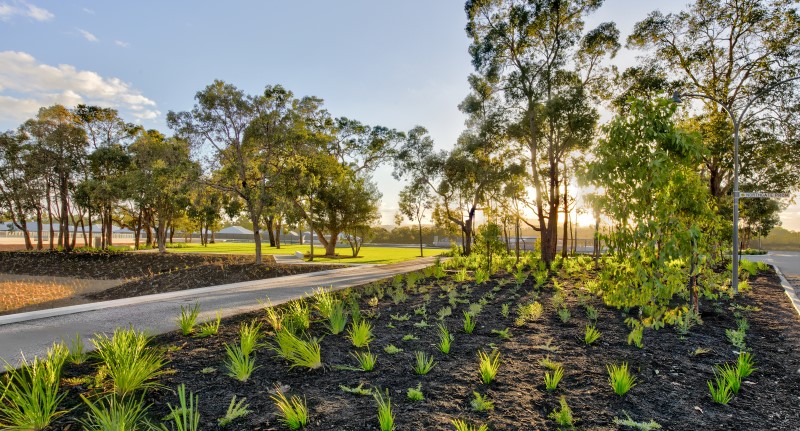- A Life Cycle Assessment (LCA) was undertaken for three land developments in Western Australia.
- Construction was the largest contributing life cycle stage at around 30% of the overall life cycle Global Warming Potential impact.
- Opportunities for improvement included electric construction equipment, minimising landscaped areas, and reduced earth movements on site.
The WA State Government has set a target to achieve net zero greenhouse gas emissions by 2050. It will take a collaborative effort across industry, all levels of government, and the community to commit to real action to meet that target and make a meaningful impact in addressing climate change.
Significantly, the property industry is the fourth biggest carbon emissions producer in Australia, and being able to accurately measure and report on those emissions is an important step in reducing the industry’s environmental impact moving forward.
To assist developers in assessing their carbon emissions and transition to lower emission practices, UDIA WA recently partnered with Cerclos, DevelopmentWA and Cedar Woods to commission a research project to complete a Life Cycle Carbon Assessment of Infrastructure works for three land developments targeting high levels of sustainability.
Cerclos is a global leader in providing life cycle assessment (LCA) software and expertise for the built environment. Their flagship software, eTool, is collaborative software for organisations to effectively measure, improve and report on the whole-life carbon emissions of their building projects.
Cerclos’ second product, RapidLCA is an app designed to drive low-carbon housing. The app offers streamlined life cycle assessment and optimisation features, crucial for designing net zero homes.
For the UDIA WA partner study, a Life Cycle Assessment (LCA) was undertaken for the three participating projects, that included a comprehensive evaluation of the project’s environmental impacts (associated with infrastructure works) across all stages from conception to disposal.
Developers provided details on the materials, construction methods and processes, energy sources, and operational elements applied in the infrastructure design.
The three land developments that participated in the study included Bushmead by Cedar Woods; OneOneFive in Hamilton Hill by DevelopmentWA; and Orion Industrial Park by DevelopmentWA.
“The goal of this study was to profile and understand the environmental performance of the infrastructure works for these three land developments,” Cerclos Co-founder and Chairman Alex Bruce said.

“A key takeaway lies in the distinctiveness of each development,” Mr Bruce said. “While certain similarities existed, numerous specific findings emerged for each project.”
Mr Bruce advised that the LCA process helps identify optimal strategies for sustainable design and informs decision-making at various project stages.
“The life cycle performance of the projects was compared to models representing business-as-usual practices and as such this was a comparative study.
“The LCA results illustrate each project’s compliance with regulatory requirements and showcases carbon reduction efforts aligned to international standards and rating schemes.”
Bushmead by Cedar Woods
Cedar Woods Director of Sustainability and Planning, Mr Karl White, said the research report is an important first step in building the company’s capacity to measure its carbon footprint when it comes to project emissions.
“We are committed to understanding and improving the environmental footprint of different development types and have a societal responsibility to ensure the work we do has a positive impact for future generations,” Mr White said.
“We know in future years we will be required to report annually on our generated greenhouse gas emissions and other climate-related impacts on the environment – this report helps us stay ahead of the curve,” Mr White said.
Mr White said Bushmead was chosen as the greenfield development for the study as sustainability was integral to the design philosophy for the community.
“The case study of Bushmead in the report demonstrates that the extensive measures we have taken to minimise environmental impact really do work.”
The use of low impact materials such as 100 per cent recycled road base resulted in the highest carbon saving at Bushmead, while the use of plastic materials for drainage, rather than traditional concrete, also resulted in less carbon emissions.
While not directly quantified in the report, Bushmead’s minimisation of landscaped areas, with the development retaining large areas of natural bushland, are expected to have a significant benefit for biodiversity and could also save significant quantities of carbon.
The detailed analysis shows the highest contributing single material to the life cycle Global Warming Potential (GWP) impact is bulk fill (sand) and the second highest contributing material is stone (for retaining and paving).
Construction is the largest contributing life cycle stage at 32.2% of the overall life cycle GWP impact.
DevelopmentWA
Acting CEO at DevelopmentWA, Dean Mudford, said that participating in the Cerclos Life Cycle Assessment Study provided an opportunity to learn more about different emissions sources in DevelopmentWA’s land development projects and the options available to reduce these emissions.
“You can’t manage what you can’t measure. This is certainly true when it comes to greenhouse gas emissions.”
Dean Mudford, DevelopmentWA
“By better understanding the top impact areas we can better address these impacts through our work with our supply chain.”
Mr Mudford said that while both projects are unique, a key finding was that both the construction impact and reoccurring energy use, such as street lighting and ground water pumping, were the biggest greenhouse gas contributors in both projects.
For the OneOneFive Hamilton Hill project, the highest contributing single material to the life cycle GWP impact is concrete, and the second highest contributing material is recycled concrete aggregate.

Like Bushmead, construction is the largest contributing life cycle stage at 29.1% of the overall life cycle GWP impact. This is the construction effort (the impact of the construction equipment itself) predominantly in relation to equipment used to move bulk fill across the site.
At Orion Industrial Park, the highest contributing single material to the life cycle GWP impact is asphalt (10% RAP) and the second highest contributing material is limestone (used as road sub-base and for retaining walls).
Again, construction is the largest contributing life cycle stage at 27.9% of the overall life cycle GWP impact.
Five environmental strategies were included in the proposed design for Orion compared to business as usual. Of those strategies, recycled and locally sourced aggregate resulted in the highest saving, followed by locally sourced limestone for sub-base.
“There are some promising changes in materials, such as concrete replacement, and energy sources, such as electric construction equipment, that could potentially reduce construction emissions. But this will take time for the industry to adapt and replace equipment,” Mr Mudford said.
“By working with our partners and suppliers and focusing on the key impact areas we can collectively transition the industry to net zero.”
Identifying opportunities
According to the final report, there are several opportunities that could be targeted to reduce the life cycle emissions of future developments. While some of these are immediate measures, others may result in higher costs or may only be possible in the future.
The identified opportunities included the use of electric construction equipment, electric freight transport, solar street lighting, minimising landscaped areas, the use of low impact materials and reduced earth movements on site.
~~
This story was originally published in The Urbanist magazine, an official publication of the Urban Development Institute of Australia (WA). It has been edited for republication by The Property Tribune.
The Property Tribune thanks the UDIA WA for the opportunity to republish the work, and share thought leadership in relation to urban development and community creation with our readers.
Read the original copy of The Urbanist by heading to UDIA WA’s website under the News tab.









